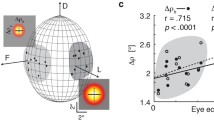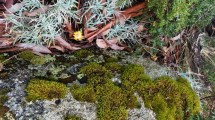Summary
-
1.
In a series of behavioural experiments designed to measure spatial acuity, freely-flying honeybees were trained to discriminate between a horizontal and a vertical grating in a Y-shaped, dual-tunnel apparatus (Fig. 1). Each grating was placed at the entrance to a tunnel, and one of the gratings carried a reward of sugar solution. After training, the spatial frequency of the two gratings, as seen from the tunnel entrances, was varied by varying, symmetrically, their distances from the tunnel entrances. At each spatial frequency, the bees' response (percentage correct discriminations) was calculated from the number of entrances that they made into the tunnels associated with the rewarded and unrewarded gratings, to obtain Response-versus-spatial-frequency (RSF) curves (Figs. 3–5, 10–12).
-
2.
In general, response decreases with increasing spatial frequency. With black-and-white gratings, the RSF curve exhibits a corner spatial frequency (corresponding to a response level of 65%) of ca. 0.25 cycles per degree of visual angle (c/deg), and the response is statistically indistinguishable from the 50% level (corresponding to random choice) at a spatial frequency of ca. 0.34 c/deg (Figs. 3, 4).
-
3.
The shape of the RSF curve does not depend upon which grating is rewarded (horizontal or vertical). Similar RSF curves are also obtained when bees are trained to discriminate a horizontal or a vertical grating from a uniform grey field (Figs. 4, 5). These results imply that the acuities in the horizontal and vertical plane at the front of the eye are essentially equal for freely-flying bees.
-
4.
An independent estimate of spatial acuity was derived by analysing video-films of the bees' flight trajectories when they approached the incorrect stimulus (Figs. 6–9). This analysis estimates acuity to be slightly poorer (corner spatial frequency: ca. 0.18 c/deg) than that inferred from the RSF curves. The films also confirm that the bees use the frontal regions of their eyes in making the visual discrimination (Fig. 10).
-
5.
Detailed observation of the bees' decision behaviour indicates that, when the stimuli in the two tunnels cannot be distinguished at the tunnel entrances, each individual choice that a bee makes between the two tunnels tends to be independent of the outcome of the previous choice. That is, the success or failure of a choice is not memorized.
-
6.
Comparison of acuity measured behaviourally with that predicted from the optical characteristics of the compound eye, reveals that the bees' capacity to discriminate orientation of linear gratings is limited primarily by the size of the visual fields of individual photoreceptors.
-
7.
Experiments conducted using grey gratings, and dual-colour gratings which provide contrast exclusively to a single spectral class of receptors (blue or green) reveal that orientation discrimination of vertical and horizontal high-spatial-frequency gratings is mediated chiefly by the greenreceptor channel, and is therefore colour-blind (Figs. 10–13).
-
8.
Experiments investigating orientation discrimination of dual-colourradial gratings reveal an acuity that is poorer andnot colour-blind (Fig. 14). We suggest that, besides the high-acuity colour-blind mechanism, there is another mechanism that is not colour blind, works on the basis of a memorized, colour-coded spatial template, and has lower spatial acuity.
Similar content being viewed by others
Abbreviations
- API :
-
acuity performance index
- c/deg :
-
cycles per degree
- MTF :
-
modulation transfer function
- RSF :
-
response vs. spatial frequency
References
Autrum H, Wiedemann I (1962) Versuche über den Strahlengang im Insektenauge. Z Naturforsch 17b:480–482
Cheng K, Collett TS, Wehner R (1986) Honeybees learn the colours of landmarks. J Comp Physiol A 159:69–73
Dartnall HJA, Bowmaker JK, Mollon JD (1983) Microspectrophotometry of human photoreceptors. In: Mollon JD, Sharpe LT (eds) Colour vision:physiology and psychophysics. Academic Press, London New York, pp 69–80 (see Fig. 1, p 72)
Daumer K (1956) Reizmetrische Untersuchungen des Farbensehens der Bienen. Z Vergl Physiol 38:413–478
De Monasterio FM, McCrae EP, Newlander JK, Schein SJ (1985) Density profile of blue-sensitive cones along the horizontal meridian of macaque retina. Invest Ophthal Visual Sci 26:289–302
Eheim WP, Wehner R (1972) Die Sehfelder der zentralen Ommatidien in den Appositionsaugen vonApis mellifica undCataglyphis bicolor. Kybernetik 10:168–179
Goetz KG (1965) Behavioural analysis of the visual system of the fruitflyDrosophila. In: Nye PW (ed) Proceedings of the Symposium on information processing in sight sensory systems. California Institute of Technology Press, Pasadena, pp 85–100
Gould JL (1985) How bees remember flower shapes. Science 227:1492–1494
Helversen O von (1972) Zur spektralen Unterschiedsempfindlichkeit der Honigbiene. J Comp Physiol 80:439–472
Kaiser W (1975) The relationship between movement detection and colour vision in insects. In: Horridge GA (ed) The compound eye and vision of insects. Clarendon, Oxford, pp 359–377
Labhart T (1980) Specialized photoreceptors at the dorsal rim of the honeybee's compound eye:polarizational and angular sensitivity. J Comp Physiol 141:19–30. (see Table 1, p 25)
Laughlin SB, Horridge GA (1972) Angular sensitivity of the retinula cells of dark-adapted worker bee. Z Vergl Physiol 74:329–335
Lehrer M, Wehner R, Srinivasan MV (1985) Visual scanning behaviour in honeybees. J Comp Physiol A 157:405–415
Menzel R (1967) Untersuchungen zum Erlernen von Spektralfarben durch die Honigbiene (Apis mellifica). Z Vergl Physiol 56:22–62
Menzel R (1973) Spectral response of moving and ‘sustaining’ fibres in the optic lobe of the bee. J Comp Physiol 82:135–150
Menzel R (1979) Spectral sensitivity and colour vision in invertebrates. In:Autrum H (ed) Vision in invertebrates. (Handbook of sensory physiology, vol 7/6 A). Springer, Berlin Heidelberg New York, pp 503–580
Menzel R, Lieke E (1984) Antagonistic color effects in spatial vision of honeybees. J Comp Physiol 151:441–448
Menzel R, Ventura DF, Hertel H, de Souza JM, Greggers U (1985) Spectral sensitivity of photoreceptors in insect compound eyes: Comparison of species and methods. J Comp Physiol A 158:165–177
Mullen KT (1985) The contrast sensitivity of human colour vision to red-green and blue-yellow chromatic gratings. J Physiol 359:381–400
Schefler WC (1979) Statistics for the biological sciences. Addison-Wesley, Reading, Mass, p 48, 62
Seidl R, Kaiser W (1981) Visual field size, binocular domain and the ommatidial array of the compound eyes in worker honey bees. J Comp Physiol 143:17–26
Srinivasan MV, Lehrer M (1984) Temporal acuity of honeybee vision:behavioural studies using moving stimuli. J Comp Physiol A 155:297–312
Srinivasan MV, Lehrer M (1985) Temporal resolution of colour vision in the honeybee. J Comp Physiol A 157:579–586
Snyder AW (1979) The physics of vision in compound eyes. In: Autrum H (ed) Vision in invertebrates (Handbook of Sensory Physiology, vol 7/6 A). Springer, Berlin Heidelberg New York, pp 225–313
Stavenga DG (1979) Pseudopupils of compound eyes. In: Autrum H (ed) Vision in invertebrates (Handbook of sensory physiology, vol 7/6A). Springer, Berlin Heidelberg New York, pp 225–313
Wehner R (1981) Spatial vision in arthropods. In: Autrum H (ed) Comparative physiology and evolution of vision in invertebrates. (Handbook of sensory physiology, vol 7/6 C). Springer, Berlin Heidelberg New York, pp 287–616
Wehner R, Flatt I (1977) Visual fixation in freely flying bees. Z Naturforsch 32c:469–471
Author information
Authors and Affiliations
Rights and permissions
About this article
Cite this article
Srinivasan, M.V., Lehrer, M. Spatial acuity of honeybee vision and its spectral properties. J. Comp. Physiol. 162, 159–172 (1988). https://doi.org/10.1007/BF00606081
Accepted:
Issue Date:
DOI: https://doi.org/10.1007/BF00606081




